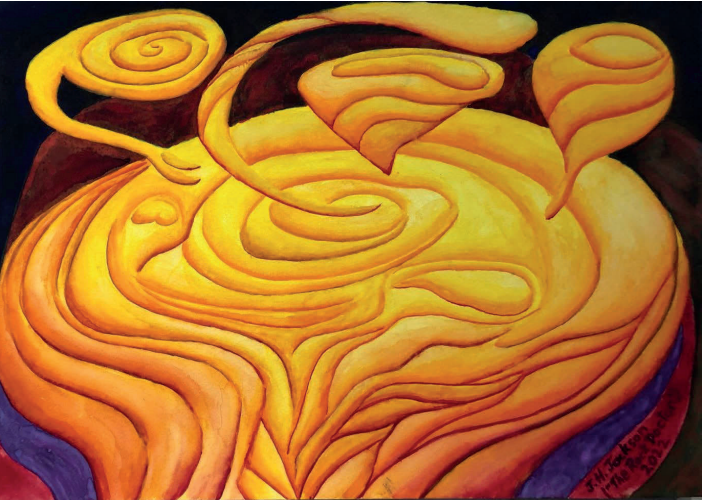TECTONICS
MANTLE TO FLOWER
Watercolour on paper,
76cm x 60cm
Recent research has suggested to me that there is still much to learn about the
movement of tectonic plates. I frequently struggle with the current
understanding of how one tectonic plate gets squeezed or subducted under
another. I continue to think there is more horizontal movement involved than
current models appear to include. I now attempt to involve horizontally
spiralling masses of mantle in my deliberations.
This artwork is based on a cross-section through the Northern Rhine Graben and
is an attempt to relate how a Moho uplift, spinning hot spot or plume in the
mantle might produce an en-échelon series of faults. These faults are thought to
have a large horizontal movement resulting in a wrench component. The faults
then evolve into a ‘flower structure’. In this case the ‘flower structure’ creates a
downthrown sedimentary basin (‘negative flower’).


SPINNING PLUME
Watercolour on paper,
76cm x 60cm
I have often wondered how to make a hot spot. I could have researched the
topic but this time I let my imagination take the journey. The following is
almost pure fiction.
Most everything I see in nature travels in spirals and yet most text-books draw
ascending magma in a vertical plane with no indication of horizontal movement.
Imagine a hot, light mantle being twisted by the underlying, spinning outer
liquid core. This twisted mantle itself starts to spin as it rises. It rises as a hot
plume, is less dense than the mantle that surrounds it and changes little in
character until it meets the lower boundary of the upper mantle at around six to
seven hundred kilometres deep. Here it’s ascent might slow down and it may
start to spin off mini plumes or hot spots
POSITIVE FLOWER
Acrylic on paper,
76cm x 60cm
Horizontal movement of rocks in different directions can result in wrenching.
When the wrenching encounters a change in orientation a flower structure is
often the result. Horizontal wrenching and associated positive flower structures
are considered to have played a major role in building the ancient Caledonian
Mountain Chain.
Flower structures are also found in sedimentary sections from the Scottish
North Sea. ‘Positive Flower Structures’ are very attractive targets for oil and/or
gas accumulations.
An example of a mega, positive flower structures are the High Atlas Mountains
in Morocco. Here a region 50 to 100 kilometres wide is dominated by
horizontal-slip faulting describing typical positive flower structures.


NEGATIVE FLOWER
Acrylic on paper,
76cm x 60cm
Horizontal movement of rocks in different directions can result in wrenching.
When the wrenching encounters a change in orientation a flower structure is
often the result. The change in direction can result in compression (‘positive
flower structure’) on the inside of a bend and in extension or tension on the
outside of a bend (‘negative flower structure’).
A flower structure in ‘geo-speak’ is described as an array of upward-diverging
fault splays within a strike-slip zone (Biddle & Christie-Blick, 1985). Flower structures
are developed from a linked system of steeper ramp faults and flat detachment
faults which are connected as complex array at depth.
Negative flower structures are found in sedimentary sections from the Scottish
Moray Firth and in Loch Ness.
